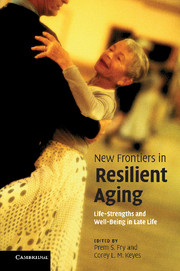Book contents
- Frontmatter
- Contents
- Figures
- Notes on contributors
- Foreword
- Acknowledgments
- Introduction
- 1 Sources of human life-strengths, resilience, and health
- 2 Growth is not just for the young: growth narratives, eudaimonic resilience, and the aging self
- 3 Physical resilience and aging:
- 4 You can teach an old dog new tricks:
- 5 Resilience in the face of cognitive aging:
- 6 Why do some people thrive while others succumb to disease and stagnation?
- 7 Psychosocial resources as predictors of resilience and healthy longevity of older widows
- 8 Resilience and longevity:
- 9 The socioemotional basis of resilience in later life
- 10 Emotional resilience and beyond:
- 11 Risk, resilience, and life-course fit:
- 12 Resilience in mobility in the context of chronic disease and aging:
- 13 Positive aging:
- Index
- References
11 - Risk, resilience, and life-course fit:
older couples' encores following job loss
Published online by Cambridge University Press: 06 December 2010
- Frontmatter
- Contents
- Figures
- Notes on contributors
- Foreword
- Acknowledgments
- Introduction
- 1 Sources of human life-strengths, resilience, and health
- 2 Growth is not just for the young: growth narratives, eudaimonic resilience, and the aging self
- 3 Physical resilience and aging:
- 4 You can teach an old dog new tricks:
- 5 Resilience in the face of cognitive aging:
- 6 Why do some people thrive while others succumb to disease and stagnation?
- 7 Psychosocial resources as predictors of resilience and healthy longevity of older widows
- 8 Resilience and longevity:
- 9 The socioemotional basis of resilience in later life
- 10 Emotional resilience and beyond:
- 11 Risk, resilience, and life-course fit:
- 12 Resilience in mobility in the context of chronic disease and aging:
- 13 Positive aging:
- Index
- References
Summary
Abstract
A long tradition of research shows job loss to be socially toxic to the health and well-being of individuals and families. In today's economy, seniority no longer means job security, as lay-offs of older workers from their career jobs are increasingly common, but often unexpected by those forced out of work. Older dual-earner couples are in double jeopardy of job lay-offs. What contributes to the resilience of women and men in their fifties and sixties confronting the crisis of job loss, as individuals and as couples? With years of adulthood before them, what ‘encores’ do they seek? We build on a combined ecology of the life-course and stress process framework to theorize four strategic adaptations of older working couples confronting displacement from one or both partners' jobs, drawing on qualitative data to illustrate how they promote resilient life-course fit: (a) changing the situation, (b) redefining the situation, (c) altering relationships, and (d) managing rising strains and tensions. We theorize and find three key resources conducive to and reinforced by a resilient encore of fit: control or mastery over one's life, social connections and support (within the couple but also with others in one's social network), and making a meaningful contribution (through paid work, civic engagement, or family work).
Introduction
A number of demographic trends – including delays in the labor force participation of younger workers, the aging of the large baby-boom cohort, changes in retirement and Social Security policies and programs – are encouraging longer labor force participation among older people, as well as new scholarly and policy interest in the growing proportion of older workers.
- Type
- Chapter
- Information
- New Frontiers in Resilient AgingLife-Strengths and Well-Being in Late Life, pp. 283 - 309Publisher: Cambridge University PressPrint publication year: 2010
References
- 3
- Cited by



